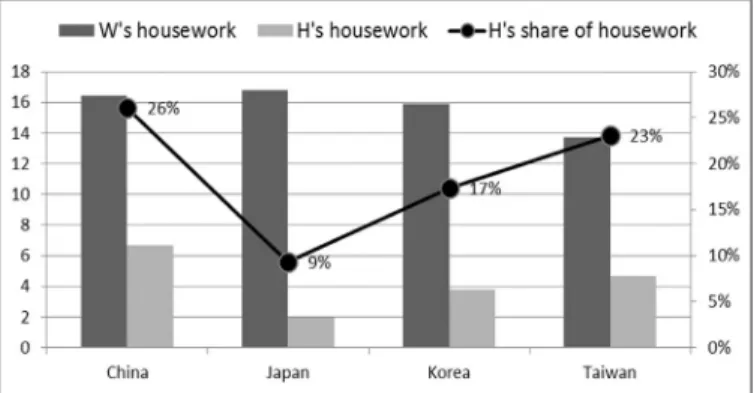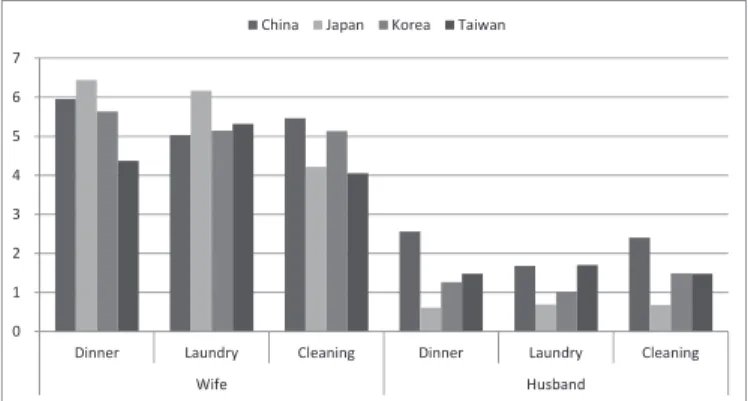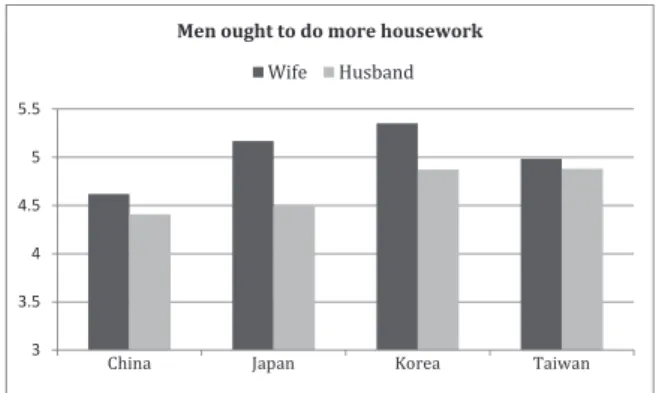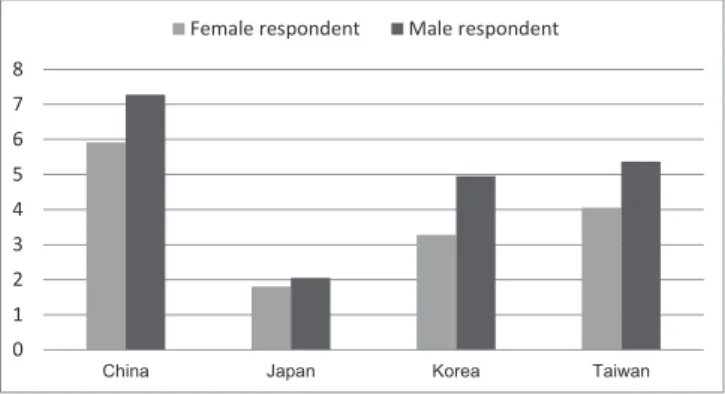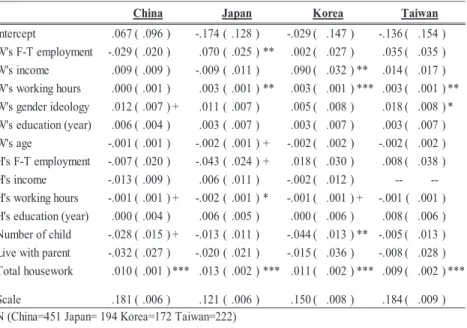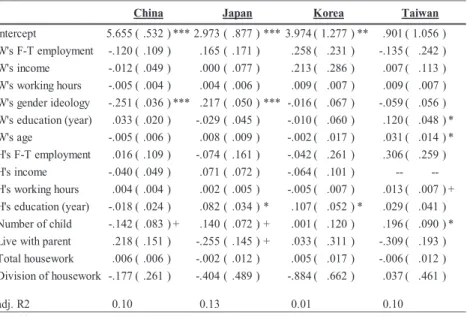Division of Housework among Dual-earner Couples in East Asian Countries: A Comparison of Chinese,
Japanese, Korean, and Taiwanese Couples Makiko FUWA*
Introduction
This study examines the division of household labor among dual-earner couples in four East Asian countries: China, Japan, South Korea (hereafter, Korea), and Taiwan. Previous studies have emphasized that the division of housework in East Asian countries is rigidly gendered; wives undertake the vast majority of housework even when they work outside the household. (Iwai, 2009; Rengo-Rials, 2009; Zuo &
Bian, 2005). Utilizing the 2006 East Asian Social Survey (hereafter, EASS) data, I analyze the division of housework among dual-earner couples in China, Japan, Korea, and Taiwan. In addition, I compare the factors affecting the division of labor in these countries, as the mechanisms affecting spouse negotiation may be different across these countries.
In previous studies, three factors—relative resources, time availability, and gender ideology—were often tested to determine whether they influence couples’
division of housework. The relative resources perspective states that the proportion of resources, such as income, that a husband and wife bring to the household affects negotiations between the couple, and the person with more resources can avoid doing the housework. Because working hours is one of the primary factors that affect how people organize their lives, longer working hours constrain a person’s involvement in other activities. Thus, the time availability perspective posits that a person with
* FUWA, Makiko Tokyo Metropolitan University, Graduate School of Humanities, Associate
Professor, fuwa@tmu.ac.jp
longer working hours participates less in housework. Finally, since traditional gender ideologies predicate that women are responsible for housework and care, people with traditional ideologies are predicted to have a more traditional arrangement, with women taking responsibility for the bulk of housework and care.
Because of severe gender inequality in the labor market in East Asian countries, many employed women are in inferior positions when they negotiate with their husbands over the division of housework. As discussed below, in the East Asian countries, gender wage gaps are evident and only small percentages of women assume positions of power in organizations. Furthermore, the impact of the three aforementioned factors on a more egalitarian division of labor is limited. Cultural and structural constraints may limit the effectiveness of these variables in realizing a more egalitarian division of labor. For instance, the impact of individual characteristics and attitudes is weaker in countries where the levels of gender inequalities and work–
family conflict are more severe (Fuwa, 2004; Fuwa & Cohen, 2007).
Moreover, because of the collectivist family ideologies that presume women’s family responsibility, women in these countries may not have strong entitlement to an egalitarian division of housework even when they work outside the home and share the breadwinner status. Previous research on housework tend to assume that negotiations between family members are motivated by maximization of self-interest, and each member’s time and resources are utilized to maximize self- interest. However, in the collectivist view of family—which many East Asian countries share—individual activities revolve around the collective interest of the family. Thus, collectivist family ideologies may prevent individual women’s employment and other resources influencing negotiation processes between spouses (Zuo & Bian, 2005).
These cultural and structural constraints in East Asian countries may not only limit men’s participation in housework, but also weaken the impact of individual women’s time and resources on the division of housework and also women’s sense of entitlement to a more egalitarian division of housework.
In this study, I analyze the division of housework in the four aforementioned
countries. I use the 2006 EASS data, comprising information from China, Japan,
Korea, and Taiwan. The sample is restricted to employed married women and men. The sample size is 3,149. In particular, this study examines the proportion of the husbands’
share of housework compared to that of their wives and the factors affecting dual- earner couples’ division of housework across the four countries. In addition, I examine the impact of socio-economic factors on women’s sense of entitlement to an egalitarian division of housework in these countries.
Gender inequality in the labor market in East Asian countries
Although many married women in these countries are in the labor force, gender inequality in the labor market has not only been severe, but also persistent. As shown in Table 1, in China, nearly 70% of women aged 15 and older participated in the labor force, in 2006. After World War II, the Chinese Government promoted gender equality in the labor market and women’s labor force participation (Ishizuka, 2010).
Table 1. Descriptive statistics for the four countries studied
China Japan Korea Taiwan Sweden U.S.
Female Labor Force Participation
a69% 48% 50% 49% 59% 60%
Gender Wage Gap
a61% 62% 49% 79% 71% 68%
Female Legislators, Senior Officials, and Managers
aShare's of Working Hours more than 50 Hours
bEnrolment in formal care and pre-school for the under 3 years
c13.2%
12% 10% 6% 18% 30% 46%
–– 27.8% 45.7% –– 5.9%
a Data is retrieved from The Global Gender Gap Report 2006 by World Economic Forum. For Taiwan, data is retrieved from Directorate General of Budget, Accounting and Statistics, Executive Yuan, R.O.C. Retrieved date is Apr 20th, 2012.
b Data is retrieved from KILM 8th edition. For the United States, the sample is waged and salaried workers. The other samples are total workers. These values were taken in 2006. A value of Korean sample is more than 49 hours from 2004 to 2005, and it is reconstructed using Messenger, J. C., Lee, S., & McCann, D. 2007. Working Time Around the World. Routledge.
c Data is retrieved from OECD family database (Participation rates in formal care and pre-school for children under six, 2006)) and the values other than for Taiwan were taken as of April, 2013. For Taiwan, data is drawn from Images of Women by Directorate-General of Budget, Accounting and Statistics, Executive Yuan, ROC. The value for Taiwan is the percentage of childcare enrollment rate for children under 3 years of age in 2003 (the sample of the statistics is limited to children of married couples).
–– 28.3% 37.7% 7.4% 45.3% 31.4%
Nevertheless, employed women often assume responsibility for household and care
work (Zuo & Bian, 2001, 2005; Cook & Dong, 2012). Furthermore, Chinese women’s
participation in the labor market has been weakening since the economic reform in 1978, as women’s labor force participation declined from 86.5% in 1990 to 81.7% in 2006 (ILO, 2013). Although female labor force participation in the other three countries is somewhat lower than that of China, approximately one-half of women aged 15 or older participate in the labor market in these countries.
Thus, women’s labor force participation is fundamental in all these countries.
However, gender wage gaps are evident. A female worker’s wage in Korea is less than half that of a male worker. Women’s wages are also approximately 60% that of men’s wages in China and Japan. The differences in the labor market structure and social policy such as the strength of the male-breadwinner model across these countries may differentiate the mechanisms by which female workers are marginalized in the labor market (Osawa, 2013). For instance, the difference in employment status between men and women explains more of gender wage gap in Japan than in Korea and Taiwan;
however, in Korea, gender gap in education and occupational placement explain more of gender wage gap than in the other countries (Chang & England, 2011). Although the gender wage ratio in Taiwan (0.79) is even higher than that of Sweden or the United States, women in Taiwan still earn less than 80% of men’s wages.
1)Moreover, in these countries, only a small percentage of women in the labor force assume positions of power in organizations. The percentage of female legislators, senior officials, and managers in China is only 12%, despite the fact that the vast majority of women are in the labor force. The percentages in the other three countries are also low: 10% in Japan, 6% in Korea, and 18% in Taiwan. These statistics indicate that female workers in these countries experience severe gender inequality in the labor market. Women’s disadvantage in the labor market, in turn, may disadvantage women in negotiation over the division of housework with their husbands.
Long working hours and the scarcity of care provision are common problems in the four countries studied, which places an extra heavy burden on married women in the labor market. In Korea, 46% of workers work more than 49 hours per week.
In Japan, 28% of workers work more than 50 hours. This suggests that in Japan and
Korea, “standard” workers are expected to work for long hours without worrying about
family responsibility. In addition, in Korea, not only regular workers but also non- regular workers are expected to work for long hours. The average weekly working hours of workers in non-regular employment were 43.1 in 2006 (Lee & Lee, 2007).
2)Furthermore, the provision of childcare services is scarce in these countries. Only a minority of children aged between 0 and 2 years are in formal childcare. Given the severe incompatibility between work and family responsibility, employed mothers are forced to choose between either dropping out of the labor market or seeking informal childcare from family members.
Conception of marriage in East Asian countries
Cherlin (2004) points out that in the United States, compliance to gender division of labor may not matter much in marital satisfaction anymore. While American couples in the 1950s tended to derive marital satisfaction from the performance in gender differentiated roles in nuclear family; breadwinner for husband and housekeeper for wife, they now expect “the development of their own sense of self and the expression of their feelings” from marital relationship (Cherlin, 2004:852). However, Cherlin’s argument may not be entirely applicable to marital relationships among East Asian couples. For instance, Kamo (1993) suggests that the factors affecting marital satisfaction are different for Japan and the United States. Instrumental aspects such as husband’s income affect marital satisfaction for Japanese couples, but not for American couples. The findings from the cross-national survey suggests that only 23% of the Japanese and Korean sample oppose the gendered division of labor, compared to 51%
in the United States and 85% in Sweden (Cabinet Office, 2002).
These East Asian countries also share conservative ideologies and a collectivist view of the family (Xie, Dzindolet, & Meredith, 1999; Zuo & Bian, 2005).
Previous studies on couples in Western countries often assume that negotiations
between spouses are motivated by maximization of self-interest. In collectivized
families, however, marital decision-making processes are governed, not by self-interest
as in Western countries, but by “norms, authority patterns, mutual trust, and familial
obligations” and patriarchal ideologies (Zuo & Bian, 2005: 604). Zuo and Bian (2005)
suggest that the 1949 Chinese Communist Revolution, in effect, strengthened family collectivism. Since decision-making power is derived according to the performance in familial obligations and male-dominance ideology, family collectivism discredits individual women’s resources in negotiation processes. This suggests that in societies that maintain the collectivist view of family, individual attitudes and situations may not have much impact on the negotiation between spouses.
Previous studies on housework in East Asian countries
Previous research suggests that, in East Asian countries, husbands’
participation in housework tends to be limited (Iwai, 2009; Rengo-Rials, 2009; Fuwa, 2012). In Japan, husbands’ participation in household labor has been low and has not increased much during recent years (Statistics Bureau, 2013). For instance, husbands in dual-earner couples in Japan share only about 10% of housework, while it is about 40% in Norway and the United States (Cabinet Office, 2007).
As suggested above, family collectivism may limit the impact of women’s economic resources and other individual characteristics on negotiations between spouses. Although the vast majority of married women in China are employed, they still perform two-thirds of the housework (Skinner & Meredith, 1998). Hsu (2008) finds that neither resource nor time availability variables have a significant effect on housework among Chinese couples. Husbands’ contribution to housework in Korea is also minimal. Husbands in Korea spend 4.5 hours on housework per week, while wives spend 15.7 hours per week (Rengo-Rials, 2009). Similarly, women in Taiwan report that they perform 72% of housework, while their husbands contribute only 28% (Hu &
Kamo, 2007).
Interestingly, although married women perform the majority of the
housework in virtually all countries, most women perceive the current division of
housework as fair (Thompson, 1991; Wunderink & Niehoff, 1997; Gager, 1998; Davis,
2010). Disagreement over housework between husbands and wives also rarely occurs
(Luppanner, 2010). It seems that culturally prescribed roles of men as breadwinners and
women as housekeepers influence wives’ judgments on their own and their husbands’
responsibility for housework (Zuo and Bian, 2001). Thus, previous studies posit that role deviance, such as a woman having a higher income, may be “neutralized” through her positive input in housework (Brines, 1993; Hu & Kamo, 2007). Furthermore, structural constraints, such as gender inequality in the labor market, may also suppress women’s sense of entitlement to an egalitarian division of housework (Braun, Lewin- Epstein, Stier, & Baumgärtner, 2008; Fuwa & Tsutsui, 2010; Fuwa, 2012).
Using the EASS, Iwai (2009) finds that the division of housework is gendered in all four countries. With regard to the economic factors affecting the division of housework, she finds that a wife’s higher income, but not the husband’s income, is associated with the wife’s housework. A wife’s longer working hours are also negatively associated with the wife’s housework frequency, except for China. In contrast, a husband’s longer working hours are positively associated with the wife’s housework only in China. With regard to a husband’s housework, a wife’s longer working hours, a husband’s lower income (except for Japan), a husband’s shorter working hours (except for China and Taiwan) are associated with a higher participation for a husband’s housework. These findings suggest that factors affecting the division of labor may vary based on cultural and socio-economic environment. However, Iwai’s (2009) study includes single-earner households in the sample. Because married women’s employment rate varies widely across the four countries, the level of work–
family conflict may also vary in these countries. Furthermore, in single-earner households—particularly when the breadwinners are husbands—the distribution of housework between husband and wife may not be an issue because it is assumed that wives will take all the household responsibility. It is when both husband and wife work outside the home, that negotiation and conflict over the division of housework becomes a serious problem. Thus, this study focuses on the division of housework in dual-earner households.
Data and methods
In this study, I use the 2006 EASS data. To analyze the division of
housework among dual-earner households, the sample is restricted to couples where
both respondents and their spouses are employed. The sample is also restricted to respondents aged between 20 and 64 years. The total sample size is 3,149 (China = 1,648, Japan = 617, Korea = 387, and Taiwan = 497). For the regression analyses, I utilize data from the female samples. In an additional analysis, I also test regression models for the male respondents, and the main results are mentioned in the notes.
The main independent variables for the division of housework model are economic resources (measured using respondents’ full-time employment status and annual income) and time availability (respondents’ working hours per week). Because respondents’ income is measured differently across the countries, I standardized their income so that the scores indicate the distance from the mean scores of each country. In addition, since inter-generational co-residence rates are higher in East Asian countries than in Western countries, a variable indicating co-residence with a parent is included in the models (1 indicates that the respondent lives either with her/his own parent or parent-in-law).
This study examines two dependent variables: (1) couples’ division of housework, which indicates a husband’s share of housework compared to the sum of a husband’s and wife’s housework; and (2) a wife’s sense of entitlement to a more egalitarian division of housework (for which, response to the question “Men ought to do more housework than they do now” is used. The response ranges from
“strongly disagree = 1” to “strongly agree = 7”). The division of housework variable is based on the sum of the frequencies of three household tasks per week: preparing dinner, cleaning, and laundry. Higher scores indicate that husbands perform more housework relative to their wives. The control variables are the respondent’s age and gender ideology, the respondent and their spouse’s educational attainment (in years), the spouse’s income and working hours, the number of children aged 18 or younger, and the total housework (husbands’ and wives’ housework frequencies are summed).
Because the Taiwan data do not contain information on the spouse’s income, I could
not include this variable in the models for Taiwan. For the analysis of the division of
housework, I employ the Tobit regression models. Ordinary Least Squares Regression
is used for the wife’s sense of entitlement to a more egalitarian division of housework.
3)I test these models separately country wise. In a supplemental analysis, I also examine whether the coefficients for the women’s resources and time availability in China, Korea, and Taiwan are significantly different from those of the wives in Japan.
Results
Figure 1 shows wives’ and husbands’ frequencies of housework (frequency of the three tasks is summed) per week and proportion of husbands’ housework relative to wives’. Employed wives perform the majority of housework in all four countries.
Average scores for wives’ housework are around 15 to 16 times per week, although wives in Taiwan perform somewhat fewer tasks than wives in the other three counties.
In contrast, husbands perform fewer tasks than their wives in all four countries.
However, there are cross-national differences in husbands’ housework. While the frequency of husbands’ housework in Japan is only two times per week, husbands in Taiwan perform twice as much (about four times per week), and husbands in China do three times as much (about six times per week) as Japanese husbands. The husbands’
share of housework ranges from 9% in Japan to 26% in China.
Figure 1. Dual-earner couples’ division of housework (China, Japan, Korea, and Taiwan)
Figure 2 shows wives’ and husbands’ frequencies for performing each task
(preparing dinner, laundry, and cleaning) for the four countries. Japanese wives prepare dinner and do the laundry most often among the four countries, while their husbands do the least. The frequency of preparing dinner for Taiwanese wives is the lowest among wives in the four countries. These results suggest that while there are some cross-national differences in the frequency of each task, the most significant factor in determining the division of household labor in all four countries appears to be “gender.”
Figure 2. Frequency of housework (dinner, laundry, and cleaning)
In this context, how do employed women in these countries perceive the gendered division of housework? Figure 3 shows the country average scores for “Men ought to do more housework than they do now” (ranges from 1 = “strongly disagree”
to 7 = “strongly agree”). Wives in Korea have the highest score among the four countries, followed by Japanese wives (5.4 and 5.2, respectively). In these countries, wives believe that they are entitled to have a more egalitarian division of housework.
The average scores for China and Taiwan are somewhat lower than those for Japan and Korea. While wives are more likely to agree with the statement than husbands in all countries, the gender gap is particularly evident in Japan and Korea. While wives in these countries perceive the division of housework as being unfair to wives, husbands in these countries do not seem to share the opinion.
0 1 2 3 4 5 6 7
Dinner Laundry Cleaning Dinner Laundry Cleaning
d n a b s u H e
fi W
China Japan Korea Taiwan
Figure 3. Mean scores for “Men ought to do more housework”
There are also gender gaps in the reporting of their own and their spouse’s contribution to housework. Previous research suggests that husbands tend to overestimate their contribution to housework. Because women, on average, spend much more time on housework, women are more skilled and have more knowledge regarding how much time they spend on housework than their husbands (e.g., Kamo 2000; Kan 2008). In addition, the social desirability of an egalitarian division of housework may be an additional factor in the men’s overestimation of their contribution. Therefore, in previous studies, the women’s reports are found being more accurate than those of the men (Kamo 2000; Kan 2008). As we can see in Figure 4, in the EASS data, the male respondents do report a higher frequency of housework than the female respondents in all countries do. The gender gap is the largest in Korea (frequencies of the male respondents’ report are 1.5 times higher than those of their female counterparts), while the gap is the smallest in Japan (the male respondents’ report is 1.1 times higher).
In China, Korea, and Taiwan, the men’s lower skills and inferior knowledge about housework may have caused the overestimation of their contribution. However, in Japan, because a considerably higher proportion of men do not participate in housework at all (24% in the female report and 17% in the male report), their reports may have ended up being more accurate.
3 3.5 4 4.5 5 5.5
Men ought to do more housework Wife Husband
Figure 4. Frequency of husbands’ housework reported by female and male respondents
In the rest of analysis, I discuss the results from the regression analyses.
Table 2 shows the Tobit regression results for the division of housework for female respondents. First, women’s full-time employment has a significant positive effect on a more egalitarian division of housework only in Japan. In addition, the effect of the women’s higher income is significant only in Korea. Women’s longer working hours have positive effects on a more egalitarian division of housework in Japan, Korea, and Taiwan, but not in China. These results indicate that the economic resources and time availability have different impacts on the division of housework across countries.
As shown in Table 2, in China, the effect of wives’ full-time employment is insignificant and shows a negative coefficient. Thus, in an additional analysis, I test whether the effects of the economic resources are significantly different from those of Japan. The results indicate that the effect is significantly smaller for wives in China than for wives in Japan. This suggests that wives in China gain less negotiating power in the division of housework from their full-time employment status. As suggested above, for China, collectivist family ideologies may constrain the impact of individual resources on the distribution of housework. Thus, women in China—even when they are employed full-time—may not be able to negotiate effectively for a more egalitarian division of housework with their husbands.
0 1 2 3 4 5 6 7 8
China Japan Korea Taiwan

